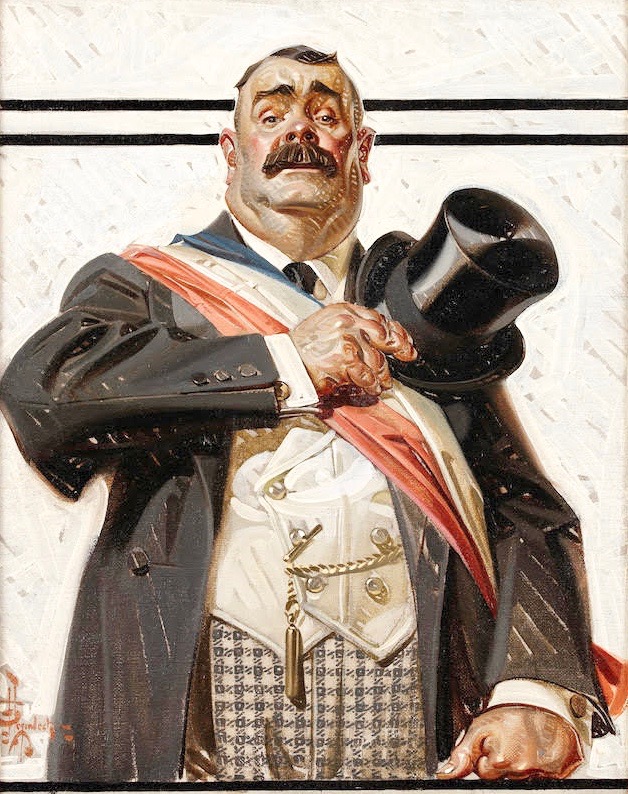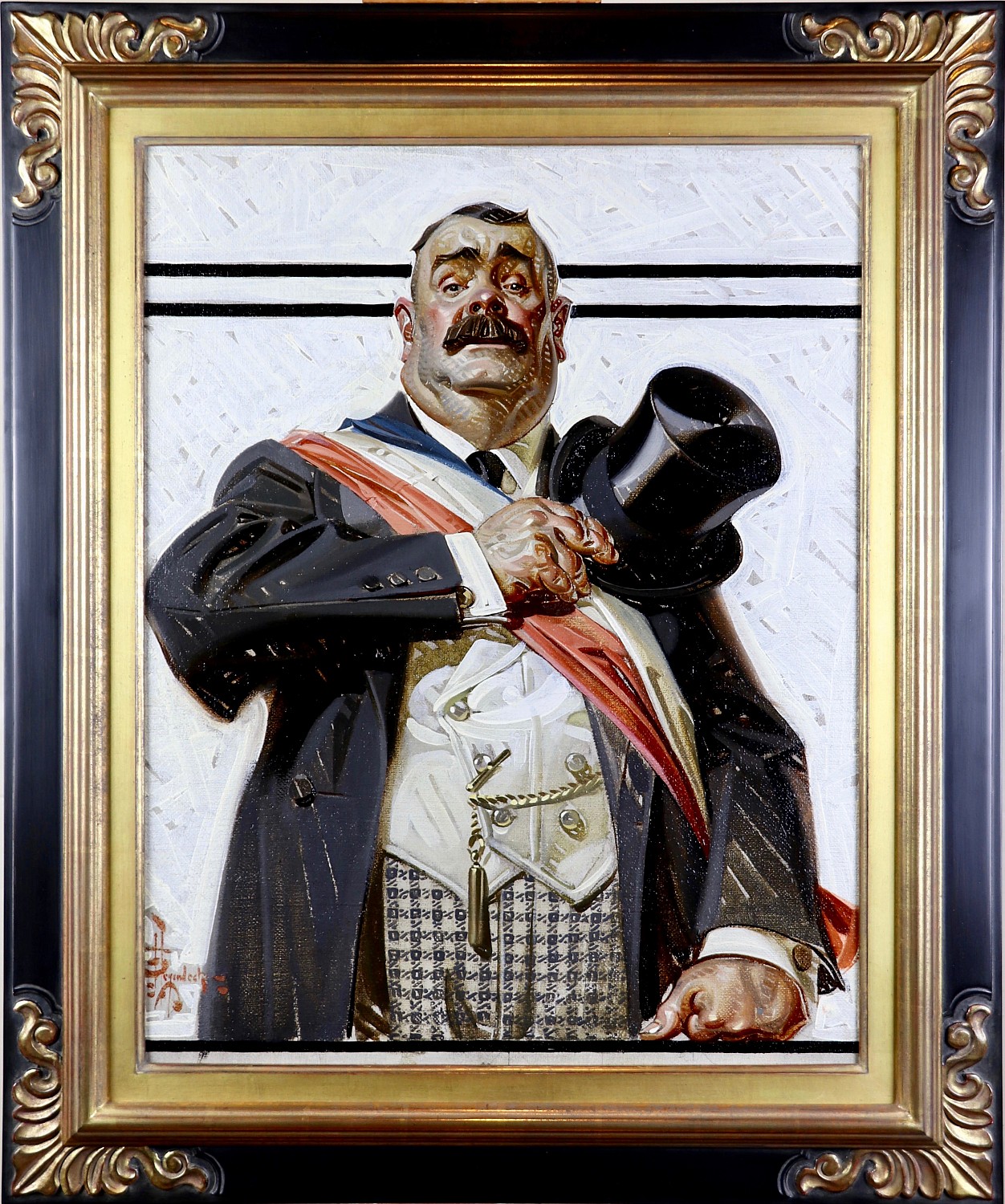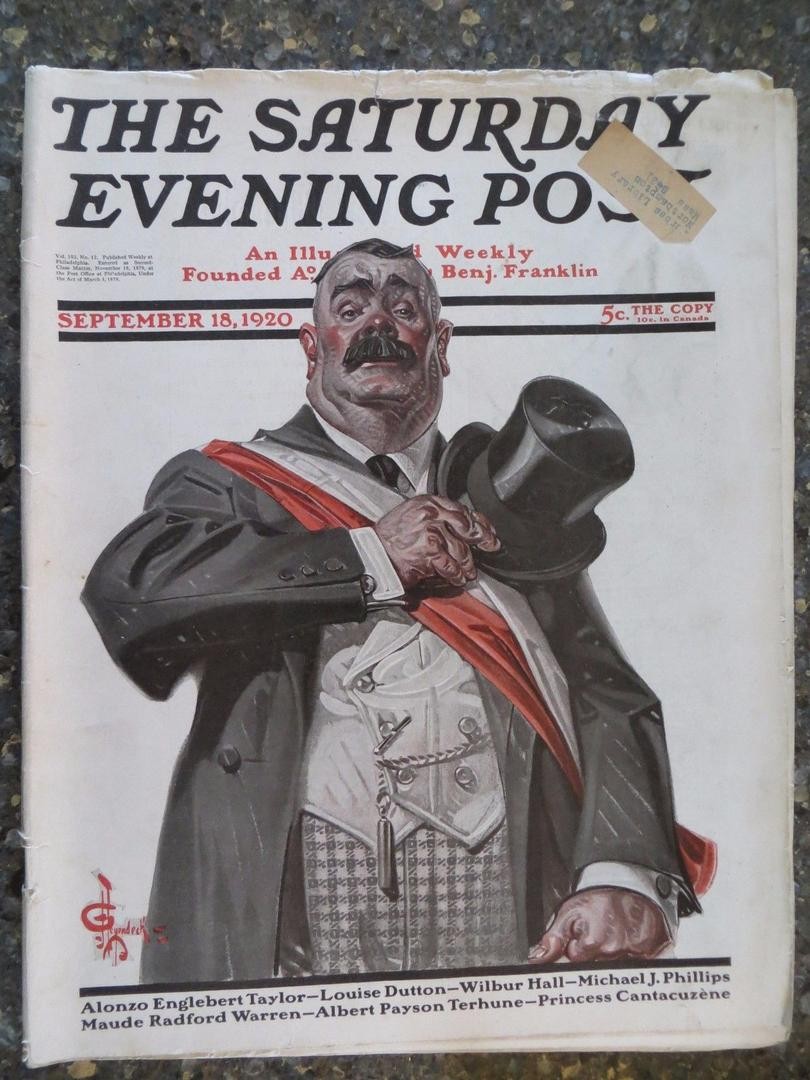"The Candidate, Saturday Evening Post Cover" Lot no. 3689
By Joseph Christian Leyendecker (1874-1951)
1920
28.00" x 22.00"
Oil on Canvas
Signed Lower Left
REQUEST PRICE
PURCHASE REQUEST
Saturday Evening Post Cover, September 18, 1920
-
Leyendecker addressed the theme of American patriotism in several ways. His famous Fourth of July covers asserted the import of American independence through stock characters: George Washington, Uncle Sam, the Statue of Liberty, colonial Freedom Fighters, and modern-day soldiers. In addition, his World War I and World War II covers depicted soldiers proudly defending their country. Leyendecker also profiled U.S. presidents and historical figures - George Washington, Robert E. Lee, William Howard Taft, and Woodrow Wilson -- who embodied dedicated leadership on behalf of the country.
Another of Leyendecker's popular patriotic types was the political candidate. His November 4, 1916 cover, for example, shows a candidate in a bowler hat delivering a stump speech, wildly gesticulating with his outstretched arm and raised fist. This particular 1920 cover, The Candidate, captures a politician wearing a flag sash and appealing to his audience in a different fashion, with a concerned, empathetic expression and his hand placed over his heart in a gesture of honor. The frontal stance of the candidate, as well as his top hat, tailored suit, and gold watch fob, also resembles that of the upper-class industrialist on Leyendecker's October 5, 1907 cover, Getting Rich Quick.
Explore related art collections: Saturday Evening Post Covers / $100,000 & Above / Patriotic/Political / Magazine Covers
See all original artwork by Joseph Christian Leyendecker
ABOUT THE ARTIST
Joseph Christian Leyendecker was born in Montabaur, Germany, and came to America at the age of eight. Showing an early interest in painting, he got his first job at 16 in a Chicago engraving house on the strength of some larger pictures he had painted on kitchen oilcloth. In the evenings after work, he studied under Vanderpoel at the Chicago Art Institute, and saved for five years to be able to go to France and attend the Academie Julian in Paris.
Upon his return, as a thoroughly trained artist with immense technical facility, Leyendecker had no difficulty in obtaining top commissions for advertising illustrations and cover designs for the leading publications. His first Post cover was done in 1899, and he did well over 300 more during the next 40 years. Among the most famous of these was his annual New Years Baby series.
His advertising illustrations made his clients famous. The Arrow Collar Man was a byword for the debonair, handsome male, and women wrote thousands of love letters to him in care of Cluett Peabody & Company. His illustrations for Kuppenheimer Clothes were equally successful in promoting an image of suited elegance. He was elected to the Society of Illustrators Hall of Fame in 1977.A major retrospective exhibition of Leyendecker's work was mounted at the Norman Rockwell Museum in Stockbridge, Massachusetts, in 1997-98.
Joseph Christian Leyendecker was born in Montabaur, Germany, and came to America at the age of eight. Showing an early interest in painting, he got his first job at 16 in a Chicago engraving house on the strength of some larger pictures he had painted on kitchen oilcloth. In the evenings after work, he studied under Vanderpoel at the Chicago Art Institute, and saved for five years to be able to go to France and attend the Academie Julian in Paris.
Upon his return, as a thoroughly trained artist with immense technical facility, Leyendecker had no difficulty in obtaining top commissions for advertising illustrations and cover designs for the leading publications. His first Post cover was done in 1899, and he did well over 300 more during the next 40 years. Among the most famous of these was his annual New Years Baby series.
His advertising illustrations made his clients famous. The Arrow Collar Man was a byword for the debonair, handsome male, and women wrote thousands of love letters to him in care of Cluett Peabody & Company. His illustrations for Kuppenheimer Clothes were equally successful in promoting an image of suited elegance. He was elected to the Society of Illustrators Hall of Fame in 1977.A major retrospective exhibition of Leyendecker's work was mounted at the Norman Rockwell Museum in Stockbridge, Massachusetts, in 1997-98.
Kent Steine





